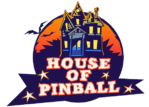Today, pinball is a beloved arcade classic. But in its early days, it was considered gambling, banned in major cities, and even raided by police. The culprit? A tiny component known as the baffle bar—a game-changing (and controversial) feature that tied pinball to Prohibition-era betting culture.
At House of Pinball, we believe every collector should understand the roots of the game they love. If you’re exploring the market for a pinball machine for sale, this historical insight could help you appreciate—and value—older machines even more.
🕰️ The Birth of Pinball: Pre-Prohibition Origins
Before electricity, before flippers, and well before digital scoring, there was bagatelle—a table game with pins and balls. This French-inspired pastime evolved into mechanical amusement devices by the early 1930s.
Manufacturers like Gottlieb, Bally, and Chicago Coin began mass-producing coin-operated machines. These games lacked flippers and relied purely on chance—balls were launched and landed into scoring pockets.
And that’s where the problems started.
💸 Enter the Baffle Bar: When Pinball Became Gambling
To increase excitement (and profits), early machines added baffle bars—metal posts or gates that redirected ball paths unpredictably. These were sometimes rigged to increase house advantage, making the game feel more like a slot machine than a skill-based arcade experience.
As cash prizes and betting pools formed around pinball, municipalities cracked down.
Notable Timeline:
- 1930s: Coin-operated pin games flood bars and speakeasies.
- 1939: New York City bans pinball, calling it a form of gambling.
- 1940s: Raids confiscate thousands of machines.
At its peak, pinball was so controversial that NYC’s Mayor Fiorello LaGuardia personally smashed machines with a sledgehammer during raids.
🍸 Pinball’s Role in the Prohibition Underground
During Prohibition (1920–1933), alcohol wasn’t the only illegal pleasure. Bars—often disguised as “ice cream parlors” or “billiard halls”—hid pinball machines that doubled as underground gambling devices.
- Wagers were placed on ball outcomes.
- Winners could earn free drinks, cigarettes, or tokens.
- Machines were often altered to favor the house, just like rigged roulette tables.
These machines, often manufactured in Chicago, gave pinball a seedy reputation that lasted decades.
🛠️ The Redemption: From Banned to Beloved
It wasn’t until 1947, when Gottlieb released “Humpty Dumpty”—the first pinball machine with flippers—that the game shifted from chance to skill-based entertainment.
Over time, manufacturers began emphasizing:
- Player control
- Scoring accuracy
- Rule sets and missions
This shift helped pinball shake off its gambling stigma. By the 1970s, machines were once again accepted as entertainment—and have since become collector’s items and centerpieces of retro gaming culture.
🔍 What This Means for Collectors Today
If you’re browsing a pinball machine for sale, knowing its historical context can increase your appreciation—and help you make smarter buying decisions.
What to Look for:
- Pre-flipper machines (1930s–1940s) are rare and often considered museum pieces.
- Machines with baffle bars or fixed gates are hot collectibles for vintage game historians.
- Machines from the post-1947 era still carry legacy influence from the Prohibition days.
At House of Pinball, we occasionally source Prohibition-era and early electro-mechanical machines. We offer transparency on each game’s history, playfield features, and mechanical originality—so you know exactly what you’re investing in.
🎯 Are These Machines Worth Buying?
| Type of Machine | Ideal For | Estimated Value |
|---|---|---|
| 1930s Baffle Bar | Historians, collectors | $$$ – Highly collectible |
| 1940s EM Machines | Nostalgic game room owners | $$ – Rare & elegant |
| 1950s+ Gottlieb | New collectors, skilled players | $–$$ – Great intro buys |
If you’re shopping for a pinball machine for sale, especially vintage titles, consider the machine’s place in history. It’s not just a game—it’s a conversation piece.
🧠 Fun Fact: Pinball Was Illegal in NYC Until 1976
That’s right—for over 30 years, pinball was banned in New York City. It wasn’t until a pinball wizard (literally, a champion player) demonstrated his skill in front of the city council that the game was finally legalized again.
📌 Final Thoughts
The story of pinball isn’t just about high scores and flashing lights—it’s a tale of rebellion, controversy, and redemption. From baffle bars in speakeasies to sleek LCD displays in today’s homes, pinball has come a long way.
At House of Pinball, we believe every machine tells a story. Whether you’re after a classic electro-mechanical game or a modern machine packed with features, we help you buy with confidence, offering transparency, trust, and a passion for the game’s incredible legacy.
🎯 Ready to own a piece of history?
Explore our selection of classic and modern pinball machines for sale at House of Pinball.

